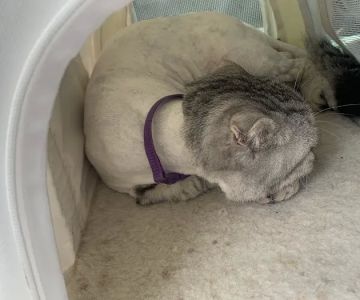How to Handle Emergency Pet Care When Your Pet is Ill
As a pet owner, one of the most stressful situations is when your beloved companion falls ill. Whether it's a sudden onset of symptoms or a more chronic issue that flares up unexpectedly, knowing how to respond can make all the difference in your pet's health. I can tell you from experience, that understanding the signs of illness and knowing what steps to take in an emergency can ease your stress and help your pet recover more quickly.
1. Recognizing the Signs of Illness in Pets
Pets, especially cats and dogs, can’t tell us exactly what’s wrong, so it’s crucial to observe their behavior for any unusual changes. The first time my dog, Max, showed signs of illness, I wasn't sure what to look for. However, over time I learned to watch for certain symptoms that indicated something was wrong. For example, changes in appetite, excessive vomiting, lethargy, or difficulty breathing are all red flags that require immediate attention.
Sometimes, the symptoms may be more subtle, such as excessive scratching or changes in coat quality. If your pet is suddenly not eating or drinking as much, or if they're avoiding their usual activities, it could be a sign of illness. I've also learned that even something as simple as changes in your pet’s bathroom habits—whether they're urinating more frequently or having difficulty doing so—can point to an underlying issue. The key is being vigilant and proactive, watching for both obvious and subtle signs of discomfort.
2. What to Do If Your Pet is Having an Emergency
When a pet becomes seriously ill, it's crucial to act quickly. I vividly remember the time when my cat, Luna, started vomiting repeatedly and became extremely lethargic. She was hiding under the bed, and I knew something wasn’t right. In those moments, panic can take over, but staying calm is essential for both you and your pet. The first step in any emergency situation is to assess the severity of your pet’s symptoms.
If your pet is exhibiting signs like difficulty breathing, uncontrolled bleeding, seizures, or signs of poisoning, you need to get them to a vet immediately. In these cases, time is critical. When Max swallowed something he shouldn’t have—part of a chew toy that he accidentally ingested—I had to rush him to the emergency clinic. It was terrifying, but knowing the symptoms and acting swiftly helped him get the treatment he needed.
3. Immediate First Aid for Pets
While waiting for professional veterinary help, you can perform some basic first aid to stabilize your pet. However, it’s essential to remember that first aid is not a substitute for proper veterinary care. It is, however, helpful in buying precious time and preventing further harm. For example, if your pet is bleeding, you should apply gentle pressure to the wound with a clean cloth. For a potential fracture or sprain, avoid moving the pet too much, and try to keep them as still and comfortable as possible.
For pets who have difficulty breathing, it's important to keep them calm and avoid exertion. In some cases, like when Max had an allergic reaction, I used a cool cloth on his body to help reduce his temperature until we could get him to the vet. If your pet has been poisoned, try to identify the substance they ingested and bring it with you to the vet. You can also contact a pet poison control hotline for immediate advice. In one instance, Luna chewed on a houseplant that was toxic to cats, and knowing what to do quickly could have saved her from a more serious situation.
4. Preparing for the Worst-Case Scenario
While we always hope that our pets will stay healthy, it's important to be prepared for emergencies. Part of my preparation includes having an emergency kit for my pets. This includes items like bandages, gauze, a muzzle (in case of fear-induced aggression), and antiseptic wipes. I've also kept a list of emergency contacts, including my regular vet and the nearest 24-hour emergency clinic, so I know exactly who to reach out to during an urgent situation.
Another thing I’ve learned over the years is that it's important to familiarize yourself with your pet’s medical history. Keeping records of vaccinations, medications, and any past health issues can be crucial in a veterinary emergency. The more information you can provide to the veterinarian, the quicker they can make an accurate diagnosis. I once had to rush Max to the vet for an unknown issue, and being able to hand over his medical records immediately helped the vet assess his situation faster.
5. Understanding Common Pet Illnesses
Pets, like humans, are susceptible to a variety of illnesses. Some are more common than others, and understanding these can help you act quickly. For instance, respiratory issues such as coughing or wheezing in pets can signal a number of different conditions, from kennel cough to heart disease. I’ve had to deal with this myself when Luna developed a persistent cough, and after a trip to the vet, we learned it was due to allergies. Fortunately, with some medication, she recovered quickly.
Another common issue is gastrointestinal upset, which can manifest as vomiting, diarrhea, or lack of appetite. This could be due to something as minor as a change in diet or as serious as a parasite infection or internal obstruction. If your pet is showing these symptoms for more than a day or if they are lethargic and weak, it’s time to seek medical attention. On one occasion, Max ate something he found outside, and his stomach started to react immediately. Knowing the signs of digestive distress and getting him to the vet quickly helped him recover without further complications.
6. Keeping Your Pet Healthy After an Emergency
Once your pet is treated for an illness or emergency, it's important to follow all aftercare instructions provided by your veterinarian. This might include administering medications, changing your pet's diet, or limiting physical activity for a period of time. I once had to care for Luna after a minor surgery, and ensuring that she stayed in a calm environment and didn’t overexert herself was key to her recovery.
For pets that are recovering from a major health scare, such as surgery or an illness, creating a comfortable and stress-free environment is vital. Keep their resting area quiet and cozy, and monitor their behavior for any signs of setbacks. If you notice anything concerning, don’t hesitate to contact your vet for advice. The last thing you want is for your pet to endure unnecessary suffering or complications.
7. Know When to Seek Professional Help
Ultimately, the most important thing you can do for your pet in an emergency is to trust your instincts. As a pet owner, you know your pet better than anyone else. If something feels off or if your pet is acting out of character, don’t wait to seek help. Even if it turns out to be a minor issue, it’s always better to be safe than sorry. If you’re ever unsure about the severity of the situation, contact a veterinarian. It’s always better to err on the side of caution when it comes to your furry friend’s health.
At the end of the day, being prepared and knowing what to do when your pet is ill can help prevent panic and reduce the risk of serious complications. Whether it’s performing first aid, getting your pet to the vet, or simply being aware of the symptoms of common pet illnesses, your quick response can make all the difference in their recovery. And for that reason, it’s always a good idea to familiarize yourself with emergency pet care before you find yourself in a crisis.











